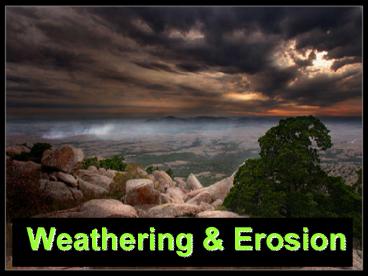Weathering - PowerPoint PPT Presentation
1 / 32
Title:
Weathering
Description:
Weathering & Erosion Weathering and Erosion Weathering is the break down of rocks that have been exposed to the atmosphere Once the rocks are broken down, the pieces ... – PowerPoint PPT presentation
Number of Views:465
Avg rating:3.0/5.0
Title: Weathering
1
- Weathering Erosion
2
Weathering and Erosion
- Weathering is the break down of rocks that have
been exposed to the atmosphere - Once the rocks are broken down, the pieces are
transported from one place to another. This
process is called erosion - Erosion is caused by wind, moving water (streams,
waves, ocean currents), ice (glaciers), and by
gravity. - Most erosion that takes place on Earth is caused
by moving water
3
Types of Weathering
- Mechanical weathering rocks are broken down
into smaller pieces without changing their
composition (doesnt change what theyre made of)
- Chemical weathering - rocks break down as their
minerals change in composition (they become
different substances)
4
Types of Mechanical Weathering
- Ice wedging/frost action
- water enters small cracks in the rock
- When it freezes, it expands and forces the crack
to open more - The process repeats over again until the rock
breaks apart
5
(No Transcript)
6
Eventually, the rock splits from repeated frost
action!
7
Types of Mechanical Weathering
- Wetting and drying
- breaks up rocks that are made from clay
- When they are wet they expand, and they shrink as
they dry - As this repeats over and over, the clay becomes
weak and cracks (think of all the projects you
have made out of claythey all crack and fall
apart)!
8
(No Transcript)
9
(No Transcript)
10
Types of Mechanical Weathering
- Exfoliation
- soil and rock is removed (glaciers or uplifting),
exposing rock found deep underground - This releases the pressure causing the surface of
the rock to expand and eventually crack
11
(No Transcript)
12
(No Transcript)
13
(No Transcript)
14
Types of Mechanical Weathering
- Plant Roots
- The deep roots of trees often break apart rocks
- Lichen Moss
- These low to the ground plants can grow on rocks
and eventually break them apart
15
(No Transcript)
16
Types of Chemical Weathering
- Hydrolysis
- water (hydro) reacts with minerals such as
feldspar and form clay
17
(No Transcript)
18
Types of Chemical Weathering
- Oxidation
- oxygen reacts with some minerals, especially
those containing iron (magnetite) to form rust
(called iron oxide) - This occurs faster with water!
19
Chemical weathering of basalt
20
Iron Banding in Basalt
21
Oxidative weathering of mineral deposits (new
deposits are white/yellow, weathered deposits are
reddish-brown)
22
Types of Chemical Weathering
- Carbonic acid
- carbon dioxide (CO²) dissolves in water to form
this acid - can cause minerals to dissolve, especially those
containing calcite
23
Gnarled Rock a formation of limestone
chemically weathered by acid rain
24
(No Transcript)
25
Factors which affect rates of weathering
- Rocks resistance to weathering (HARDNESS)
- Amount of surface area
- Climate
- Chemical weathering occurs faster in warm, wet
climates - Mechanical weathering occurs faster in cold or
dry climates
26
The central area of rock was less resistant to
weatheringthus the arch was formed!
27
(No Transcript)
28
Surface Area
- Greater surface area increases the rate of
weathering - Surface area is the amount of rock surfaces
exposed to the atmosphere - Weathering creates more surface area
29
(No Transcript)
30
Dry Climate Mechanical Weathering!
Devils Marbles, Australia Mechanical
weathering from wind and sand!
31
Warm Climate Chemical Weathering
Parthenon Athens, Greece
32
(No Transcript)































